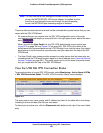
Virtual Private Networking Using SSL Connections
358
ProSecure Unified Threat Management (UTM) Appliance
2. Create authentication domains, user groups, and user accounts (see Configure Domains,
Groups, and Users on page 362)
a. Create one or more authentication domains for authentication of SSL VPN users.
When remote users log in to the UTM, they need to specify a domain to which their
login account belongs. The domain determines the authentication method that is used
and the portal layout that is presented, which in turn determines the network
resources to which the users are granted access. Because you need to assign a
portal layout when creating a domain, the domain is created after you have created
the portal layout.
b. Create one or more groups for your SSL VPN users.
When you define the SSL VPN policies that determine network resource access for
your SSL VPN users, you can define global policies, group policies, or individual
policies. Because you need to assign an authentication domain when creating a
group, the group is created after you have created the domain.
c. Create one or more SSL VPN user accounts.
Because you need to assign a group when creating an SSL VPN user account, the
user account is created after you have created the group.
3. For port forwarding, define the servers and services (see Configure Applications for Port
Forwarding on page 363).
Create a list of servers and services that can be made available through user, group, or
global policies. You can also associate fully qualified domain names (FQDNs) with these
servers. The UTM resolves the names to the servers using the list you have created.
4. For SSL VPN tunnel service, configure the virtual network adapter (see Configure the SSL
VPN Client on page 365).
For the SSL VPN tunnel option, the UTM creates a virtual network adapter on the remote
computer that then functions as if it were on the local network. Configure the portal’s SSL
VPN client to define a pool of local IP addresses to be issued to remote clients, as well as
DNS addresses. Declare static routes or grant full access to the local network, subject to
additional policies.
5. To simplify policies, define network resource objects (see Use Network Resource Objects to
Simplify Policies on page 369).
Network resource objects are groups of IP addresses, IP address ranges, and services.
By defining resource objects, you can more quickly create and configure network policies.
6. Configure the SSL VPN policies (see Configure User, Group, and Global Policies on
page 371).
Policies determine access to network resources and addresses for individual users,
groups, or everyone.


















